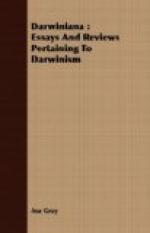This view once adopted, and this course once entered upon, has to be pursued farther. Quercus Robur of Europe with its bevy of admitted derivatives, and its attending species only provisionally admitted to that rank, is very closely related to certain species of Eastern Asia, and of Oregon and California—so closely that “a view of the specimens by no means forbids the idea that they have all originated from Q. Robur, or have originated, with the latter, from one or more preceding forms so like the present ones that a naturalist could hardly know whether to call them species or varieties.” Moreover, there are fossil leaves from diluvian deposits in Italy, figured by Gaudin, which are hardly distinguishable from those of Q. Robur on the one hand, and from those of Q. Douglasii, etc., of California, on the other. No such leaves are found in any tertiary deposit in Europe; but such are found of that age, it appears, in Northwest America, where their remote descendants still flourish. So that the probable genealogy of Q. Robur, traceable in Europe up to the commencement of the present epoch, looks eastward and far into the past on far-distant shores.
Quercus Ilex, the evergreen oak of Southern Europe and Northern Africa, reveals a similar archaeology; but its presence in Algeria leads De Candolle to regard it as a much more ancient denizen of Europe than Q. Robur; and a Tertiary oak, Q. ilicoides, from a very old Miocene bed in Switzerland, is thought to be one of its ancestral forms. This high antiquity once established, it follows almost of course that the very nearly-related species in Central Asia, in Japan, in California, and even our own live-oak with its Mexican relatives, may probably enough be regarded as early offshoots from the same stock with Q. hex.




